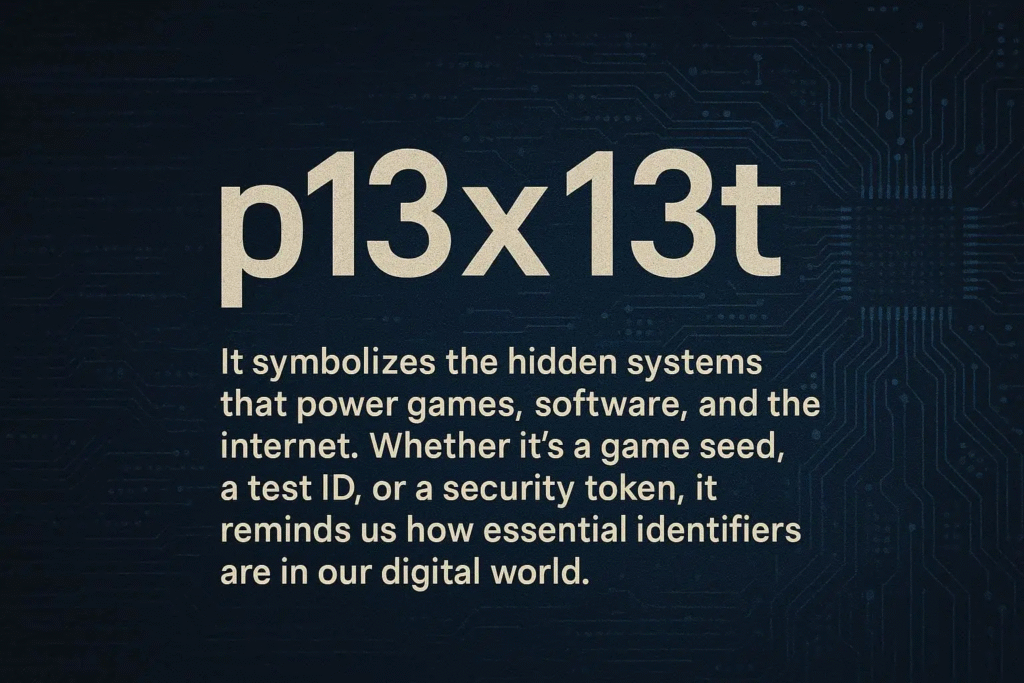Understanding p13x13t: What It Is, How It’s Used, and Why It Matters
Introduction
In today’s digital world, strange codes and identifiers often appear in games, apps, and software logs. One of these mysterious strings is p13x13t.
If you’ve ever come across this term, you may have wondered what exactly p13x13 t is. Is it a random code, a hidden seed, or something more meaningful?
This article explores everything you need to know about p13x13t its meaning, possible origins, uses in gaming and software, and why such identifiers matter in modern technology.
What is p13x13t?
At its simplest, p13x13t is an alphanumeric string, a mix of letters and numbers. It looks random, but follows a pattern: p + 13 + x + 13 + t.
While there is no official documentation explaining its exact origin, experts believe it functions as a code, seed, or unique identifier used in digital systems.
You’ll often find similar patterns in:
- Game world seeds
- Software testing tags
- Encryption tokens or debug codes
In short, p13x13t isn’t a regular word. It’s more like a digital fingerprint used to represent something specific in a game, app, or online environment.
Possible Origins of p13x13t
Because there’s no confirmed source, we can only infer where p13x13t might come from. Here are a few realistic possibilities:
1. Software or Programming Identifier
In programming, developers use mixed alphanumeric codes to label variables or test cases.
p13x13t could easily serve as a test ID, debugging label, or placeholder variable. The middle section “13×13” might refer to dimensions (13 by 13), a version, or just a pattern for uniqueness.
2. Gaming Seed or Map Code
Many games, especially sandbox or world-generation titles like Minecraft, use random text strings to create unique worlds.
If you enter p13x13t as a seed, the game could generate a specific world layout or structure. Players sometimes share such seeds online to recreate identical maps.
3. Encryption or Security Key
Another possibility is that p13x13t is part of a hash, session token, or encryption tag. Random-looking strings like this are commonly used to ensure uniqueness and protect digital systems.
4. Internet Curiosity or Meme
Lastly, the internet has a habit of turning mysterious codes into viral curiosities. Some users share p13x13t simply because it looks intriguing or cryptic, sparking online discussions and theories.
How is p13x13t used?
Let’s look at how p13x13t might appear in different digital contexts.
In Gaming
In games, p13x13t could serve multiple roles:
- World seed – Determines how a procedurally generated map looks.
- Unlock code – Triggers special modes, items, or challenges.
- Community reference – Shared among players to access a specific setup.
For example, someone might say:
“Use the seed p13x13t for a 13×13 island challenge!”
In Software Development
In software, p13x13t may function as:
- A test case name (e.g., test_p13x13t)
- A temporary user ID or session identifier
- A variable key in databases or APIs
Its structured yet uncommon format helps avoid duplicates and keeps systems organized.
In Cybersecurity or Encryption
Although not proven to be part of any official encryption, codes like p13x13t often act as tokens or hash fragments.
They might appear in URLs, session cookies, or logs to maintain unique security references.
In Online Culture
Some users post about p13x13t out of curiosity. Discussions on tech or gaming forums sometimes treat it as a mysterious “digital easter egg.”
Its randomness makes it appealing, a kind of digital riddle that people like to decode.
Why Does p13x13t Matter?
Even if p13x13t isn’t a famous code, studying it can teach us valuable lessons.
1. Digital Literacy
Learning about p13x13t helps users understand that not every code or number online is random. Many represent hidden identifiers within games or apps.
2. Troubleshooting Knowledge
If you spot p13x13t in a log file, game setting, or website, you’ll know it’s likely a seed, tag, or internal ID not an error.
3. Security Awareness
Recognizing random-looking strings like p13x13t reminds us to treat unknown codes carefully, especially in URLs or software. Some could be sensitive session keys.
4. Cultural Curiosity
Finally, p13x13t demonstrates how the internet transforms obscure strings into viral mysteries, sparking curiosity and digital exploration.
How to Handle p13x13t When You See It
If you ever encounter p13x13t, here’s how to react wisely:
1. Check the Context
Ask yourself where it appeared:
- In a game? (Probably a seed or cheat code)
- In software logs? (Likely an internal identifier)
- On a website or URL? (Could be a tracking token)
2. Determine Its Purpose
Context will reveal its intent. If it’s in an editable field, it might generate or unlock something.
If it’s hidden in code, it probably serves as a system tag.
3. Test Safely
If you’re experimenting, only do so in safe environments.
For example, entering p13x13t into a sandbox game is fine. But never paste unknown strings into private or secure fields.
4. Research It
You can look up p13x13t online to see how others have encountered it. Discussions might give clues to its role or usage.
5. Protect Private Data
Never share screenshots, URLs, or tokens containing p13x13t if they’re from private systems. It might be linked to your account session.
Common Misunderstandings About p13x13t
Myth 1: p13x13t is a Virus or Malware
There’s no evidence suggesting p13x13t is malicious. It appears in neutral contexts often as a harmless identifier.
Myth 2: It Has One Fixed Meaning
Different platforms may use p13x13t for completely different purposes.
It might be a game seed in one system and a debug tag in another.
Myth 3: It’s an Official Standard
No public documentation defines p13x13t as a recognized standard. It’s likely an internal or symbolic identifier.

Breaking Down the Structure of p13x13t
Let’s look at each part of the code:
- p – Could represent “project,” “player,” or “program.”
- 13×13 – A symmetrical number often used in grid-based systems or games.
- t – Might stand for “test,” “token,” or simply a suffix to distinguish versions.
If interpreted, p13x13t could loosely mean “program 13×13 test,” though this remains speculative.
Example Scenarios Involving p13x13t
Scenario 1: In a Game
A player enters p13x13t as a seed in a world-generation game.
The game creates a unique 13×13 layout with balanced terrain. Players share it online as a fun map challenge.
Scenario 2: In a Software Test
A developer runs a code simulation labeled test_p13x13t to monitor behavior under specific parameters.
Later, this identifier appears in logs, allowing the team to track the results efficiently.
Scenario 3: In a Cybersecurity Token
A website assigns the session ID p13x13t to a temporary user.
It helps authenticate and track user actions securely while keeping data private.
The Significance of Codes Like p13x13t
Random-looking identifiers like p13x13t are vital in modern computing. They ensure uniqueness, randomness, and structure in digital environments.
Such strings reduce confusion, maintain order, and prevent duplication across millions of entries.
Whether in gaming, databases, or encryption, these identifiers act like fingerprints, unique, small, and powerful.
The Curiosity Factor: Why People Search for p13x13t
People are naturally drawn to mysterious digital codes.
When users encounter p13x13t in a file or forum, they often Google it, hoping to find an explanation. This curiosity helps spread awareness about data identifiers and seed systems, even if the exact origin remains unknown.
Conclusion
p13x13t may look like a random code, but it symbolizes something bigger: the hidden systems that power games, software, and the internet.
Whether it’s a game seed, a test ID, or a security token, it reminds us how essential identifiers are in our digital world.
By understanding and respecting such strings, users become more digitally literate, curious, and aware of the invisible mechanics behind technology.
So next time you see p13x13t, you’ll know it’s more than just letters and numbers, it’s a small window into the logic and structure of our connected digital universe.
Quick Facts About p13x13t
| Fact | Details |
|---|---|
| Type | Alphanumeric Identifier |
| Common Uses | Game seeds, software tags, tokens |
| Possible Meaning | “Program 13×13 Test” (speculative) |
| Origin | Unknown / Digital context |
| Safety | Harmless in general use |
| Popularity Reason | Internet curiosity and mystery |
| First Noticed | Around the early 2020s, online forums |
FAQs About p13x13t
1. What is p13x13t used for?
It’s often used as a unique identifier or seed in digital systems, games, or test environments.
2. Is p13x13t a virus or scam?
No, there’s no evidence that p13x13t is harmful or related to malware.
3. Can I use p13x13t in games?
Yes! Some players use it as a world seed or custom code to explore unique game maps.
4. Does p13x13t have an official meaning?
No. It’s a speculative code, mostly recognized for its mysterious appearance online.
5. Why is p13x13t trending online?
Because people are curious about unusual alphanumeric strings, and p13x13t has become one of those digital mysteries.














Post Comment